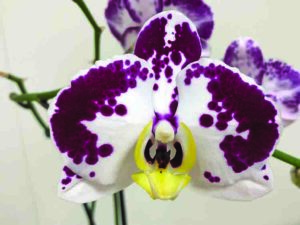Phalaenopsis, or the moth orchid, is one of the easiest of orchids to grow.
They love to live in houses for the same reason we love to live in our homes, where there are sunny rooms and the inside temperature is between 70 to 82 degrees F.
They love to live in the sunlight from an east, south or west window, and do best beside the window for the filtered light rather than in direct sunlight.
The leaves will let you know if it is happy; an olive green leaf color is a happy moth orchid. A dark green leaf says it is not getting enough light while a reddish cast lets you know the plant is getting too much direct sun light. 
All plants like humidity, but when the moth orchid is not in flower, it is fine with low humidity. Once it starts to flower, it does prefer more humidity that can be achieved by placing the orchid container on a shallow tray of pebbles and keeping water in the tray to provide more humidity.
Watering the moth orchid once a week is usually enough to keep your plant healthy and happy.
Because the orchids are tropical, they prefer to be watered with slightly warm or lukewarm water and not with ice cubes.
If you are in doubt on how much water to pour over the aerial roots, you can put the number of ice cubes recommended for the orchid (usually two or three) into a measuring cup.
Once the cubes have melted and the water is room temperature, water the plants.
In the wild, the moth orchid wraps its aerial roots around the trunks of trees and the orchids get both water and nutrition during the rain storms.
As the rainwater washes over the leaves of the trees, it gathers small amounts of nutrients that leak out of the leaves and deposits them onto the leaves of the orchid.
It is important to remember that the aerial roots do not like to be buried into soil.
They just need enough of those roots into the bark mixture to stabilize the plants so they don’t fall out of the containers.
Firm white colored roots show a happy and healthy plant while brown roots show a plant in trouble, usually from over-watering.
Once the moth orchid starts to bloom, use thin bamboo poles or wooden rods to help guide the flower stalks upright.
The flower stalks can be clipped into place with tiny hair clips or soft yarn can be tied around the stalks.
The flowers will slowly open in vibrant colors of pure white, white with pink center, pink, purple, yellow with red and white with colorful splotches.
These lovely flowers can bloom and be enjoyed for months.
Once they are finished blooming, trim the flower spike down to the brown band near the foliage.
The orchid should bloom again in two to three months.
(Editor’s Note: Ginny Rosenkranz is a commercial horticulture specialist with the University of Maryland Extension.)



